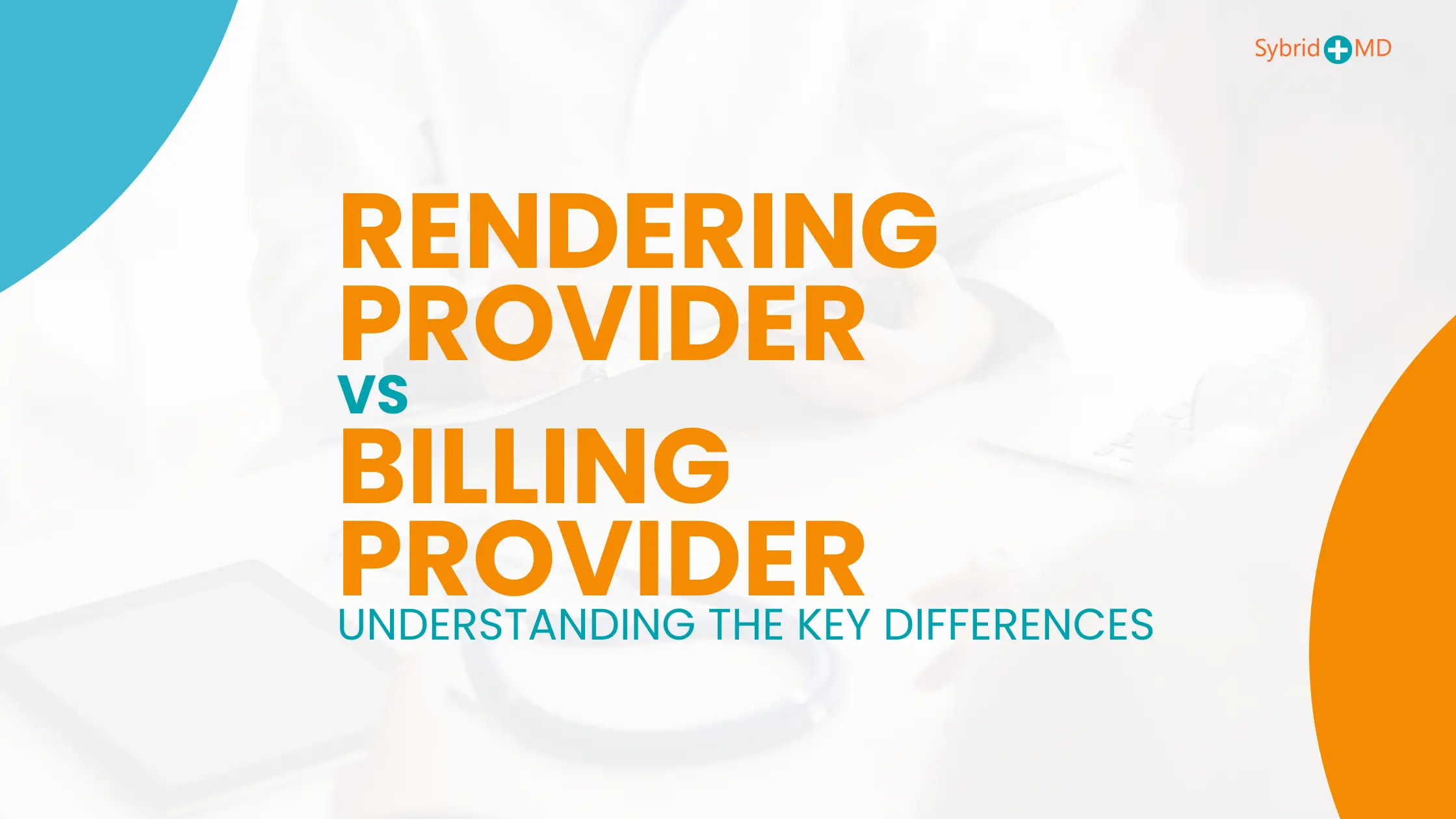In healthcare, the terms “rendering provider” and “billing provider” are often used interchangeably, but they represent two distinct roles in the medical billing process. Understanding rendering provider vs billing provider is crucial for proper medical claims submission and reimbursement, ensuring accurate processing of healthcare services.
This article will dive deep into billing provider vs. rendering provider and also difference between billing provider and rendering provider, explore what each term means, and provide clarity on why these roles matter in the billing cycle.
What is a Rendering Provider?
A rendering provider is the healthcare provider who actually renders medical care to a patient. This is a physician, nurse practitioner, or other licensed provider who performs the clinical procedures, tests, or consultations for which a patient is requesting. In essence, the rendering provider is the service provider that ‘renders’ or provides the service to the patient.
One example would be if the patient had a consultation with a general practitioner in a doctor’s office, that physician would be the rendering provider. For example, in a hospital, the surgeon who conducts an operation would be the rendering provider. Rendering provider is the person who directly interacts with the patient and provides care which is paramount hence their role.
What is a Billing Provider?
On the other hand, a billing provider is the entity or organization responsible for submitting the medical claim to the insurance company. While the rendering provider delivers the care, the billing provider is in charge of submitting the claim for payment.
Often, the billing provider and the rendering provider can be the same person, particularly in private practices, where one doctor provides the care and her practice office does the billing. In more complicated environments like hospitals or clinical settings, the billing provider can be a health care system, a third-party billing company, or maybe even a particular unit within the institution.
If a surgeon performs surgery on a patient in a hospital, for example, the surgeon is the rendering provider, but the hospital or its billing department is the billing provider. The reading will be the claim for re-sensitive care by the input entry.
Difference Between Billing Provider and Rendering Provider
The difference between billing provider and rendering provider can be broken down into several key aspects:
- Role in Service Provision: The rendering provider is the one providing health care services to a patient. Nevertheless, it is still the responsibility of the billing provider to address the financial components of the transaction, including submission of the claim for services, continual follow-up on claims and receiving payment.
- Interaction with the Patient: The rendering provider interacts with the patient during medical procedures or patient consultations. This is the entity that sets the administrative and financial side of care they never deal with the patient.
- Claims Submission: The rendering provider does not submit claims; the billing provider submits the claim. After coding, this information is sent to the insurance company or payer by the billing provider.
- Payment Responsibility: Services are performed by the rendering provider, and the billing provider collects (or is reimbursed for) those services and may share that payment with the rendering provider through their employment or contract agreements.
- Regulatory Requirements: Different regulation around rendering and billing providers Whilst the rendering provider will always be a licensed healthcare professional, the billing provider may be a healthcare entity or an outsourced billing agent.
Rendering vs Billing Provider: The Important Distinction
The terms rendering vs billing provider can be confusing, especially when both roles are closely related. However, understanding the distinctions is key to ensuring the correct submission of claims and avoiding any potential billing errors or payment delays.
For example, when insurance companies want to conduct a review of a claim they might often need to know who rendered the service (rendering provider) as well as who is performing the billing (billing provider). Mistakes in either area can result in rejections of claims, delayed reimbursements and, in extreme cases, fraud investigations.
Errors in identifying either provider can lead to a host of complications. So, there are times for example, the rendering provider being incorrect or an unauthorized person being listed as the billing provider that you might see an insurance company deny a claim outright. Without the proper billing provider registration behind a claim, the insurance company may initiate a claim denial or simply defer action until they receive the appropriate provider details, which can all place significant financial strain on healthcare providers.
Also, billing errors can trigger red flags for fraud investigations, particularly if there is a history of incorrectly identifying providers or billing for nonexistent services. The role of each party must be clear and accurate information should be provided when it comes to dealing with medical claims not only to avoid the errors but also to ensure that they are compliant with the insurance regulations and also to protect the integrity of healthcare billing practices.
Why the Difference Matters in Medical Billing
Understanding the difference between billing provider and rendering provider is critical in medical billing for several reasons:
Claims Accuracy: It makes sure that claims are submitted with relevant data which only reduces the possibility of errors or denials.
Insurance Compliance: insurance companies ask for specific details of the rendering provider and the billing provider as well; Not correctly submitting this information with your claim can result in its rejection.
Payment Process: If the provider listed as billing provider is incorrect, payer would either send payment to an incorrect entity or payment may get delayed. Identification also makes sure that payment for the service is made on time.
Preventing Fraud: Incorrectly representing the rendering provider or billing provider leads to fraudulent claims, which can result in significant legal and financial ramifications. Differentiating between these roles correctly ensures compliance with healthcare regulations.
What Happens if the Roles are Confused?
When there is confusion or overlap between the billing provider vs rendering provider, several issues may arise:

Claim Rejections
Incorrect or inconsistent information regarding the initiating billing provider and/or billing provider will lead to claim rejection, which can have serious effects on a practice’s cash flow. Illustratively, an incorrect listing of the rendering provider could lead the insurance company to assume they are not qualified to provide the service required, which will cause claim denial. A similar scenario occurs when the billing provider gets inactivated or canceled in the provider file of the insurance company; in such cases, the provider claim will not be processed, making the reimbursement process fail.
Delayed Payments
Billing provider identification errors can create significant processing delays. If the billing provider is not listed properly, the insurer may be unable to extract values from the information, causing potentially very long delays in reimbursement. Small practices, in particular, are paying the price for these payment holdups, relying on timely reimbursements to keep up with expenses like staff salaries, medical supplies and other operational costs. Late payments can lead to financial strain, which in turn may affect the quality of patient care and the health of the business.
Regulatory Scrutiny
Incorrect or inconsistent reporting of the rendering provider and billing provider may draw scrutiny from healthcare regulators. Even if unintentional, billing mistakes may trigger audits of a provider’s billing practices or investigations of a provider by a government entity. Billing and coding are closely scrutinized by regulators, who view them under the lens of compliance with federal and state laws; any discrepancies might be seen as potential fraud or abuse.
If an investigation reveals billing practices are not in compliance with regulations, providers may be subject to severe fines, penalties, and/or legal action. Misclassification or improper documentation done repeatedly could hurt the provider’s reputation, damaging their ability to work with insurers.
Administrative Burden Increases
Misclassification of the rendering and billing provider will only add to the administrative burden placed on healthcare practices. It results in claim rejections and delayed payments, costing time and resources to resolve. Practice personnel must waste valuable time checking and correcting billing data, contacting insurance companies and re-submitting claims.
Such workflow inefficiencies siphon time and energy away from patient care impacting, the practice’s overall productivity. By helping to ensure the right provider at the right time and place, administrative errors can be minimized, resulting in fewer problems and less overhead.
Loss of Trust and Reputation
Getting the billing process wrong again and again might tarnish a healthcare providers name. Providers who repeatedly use the wrong rendering provider or billing provider risk losing confidence from insurance companies, patients, and even potential business partners. In a competitive health care environment in which patients have an abundance of choices for care, this loss of trust can be particularly damaging.
Conclusion
In conclusion, while both rendering vs billing provider play critical roles in the healthcare industry, understanding their respective responsibilities is essential for proper medical claims processing. The rendering provider is responsible for delivering care directly to the patient, while the billing provider is tasked with submitting claims and handling the payment process.

